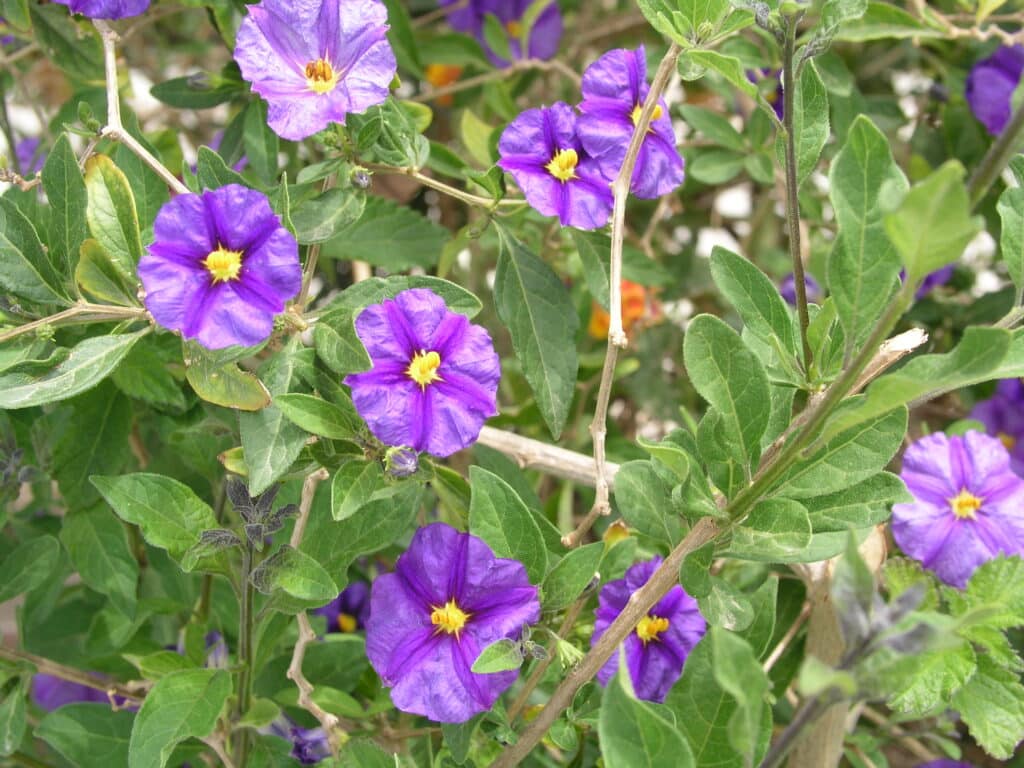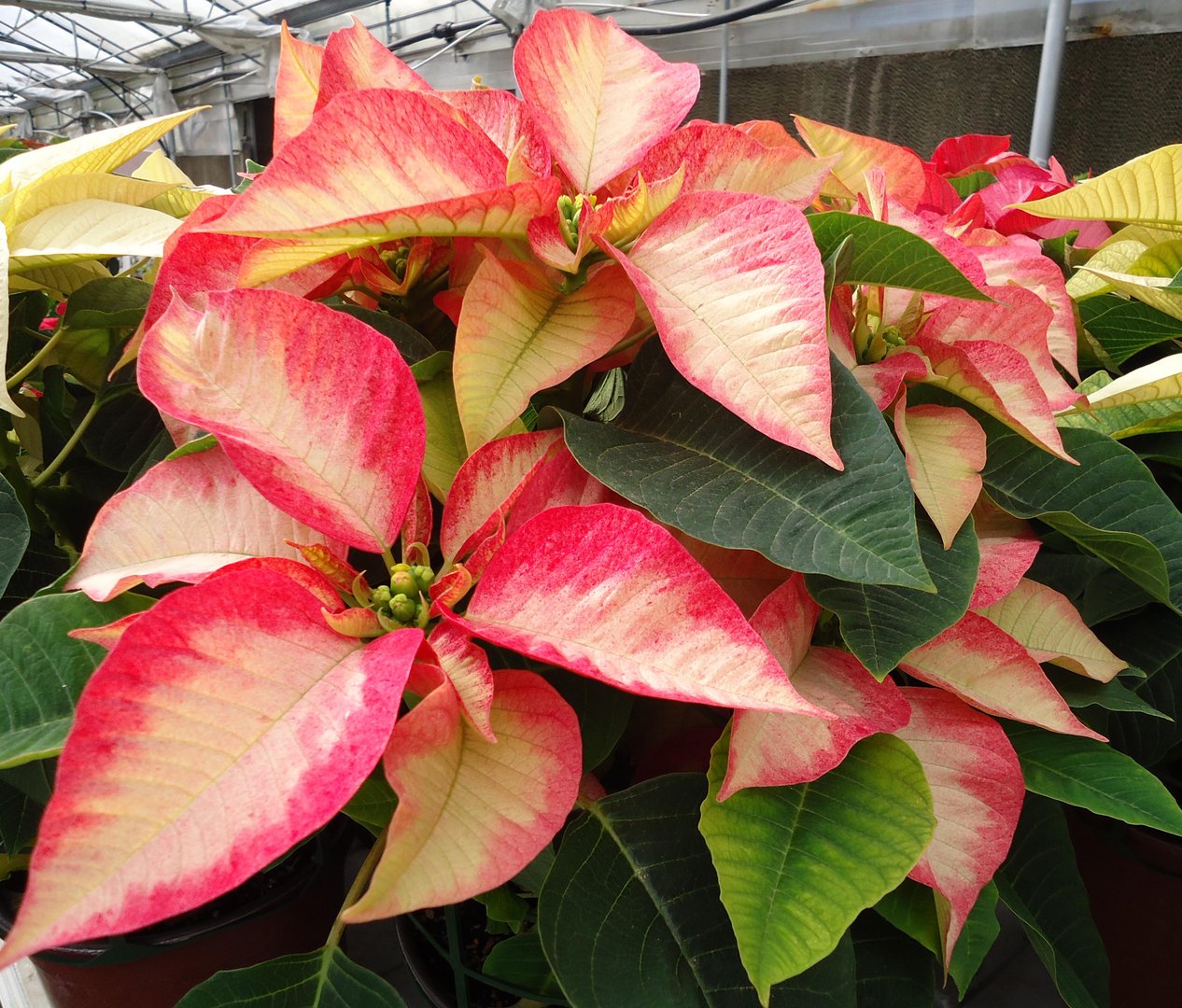There is still a lot going on in the garden this month. Unlike more northerly parts of Europe where winter has set in and gardens can be covered with frost and in some places snow, here we can be enjoying reasonable temperatures and lots of warm sunshine.
The air is full of the heady scent of loquat flowers and the pretty leaves of tiny cyclamen are popping up under trees and in sheltered places. Freesias and ornithogalums continue to grow at a fast rate along with osteospermums, some of which are already in flower. Seedlings are popping up through the ground and cuttings still putting out roots.
In some old village gardens, you may see tree poinsettias in bloom, which really need a humid environment in which to grow. Their bracts are a different shape to the potted variety, more elongated and have a bigger cluster of yellow flowers in the centre.
Originally found growing wild in southern Mexico by Joel Robert Poinsett, an amateur botanist, they were developed over many decades to those we know today. They were said to be found in American nurseries as long ago as 1836 and have been popular there since then. I can’t remember them being in my mother’s home when I was a child, so I wonder when they started to be regarded as ‘the’ Christmas flower in Europe. In America there is even a special day dedicated to them – December 12!
A reminder that poinsettias belong to the Euphorbia family, which all have a milky sap, so that when a stem breaks off, this sap oozes out. Some people are allergic to this, so take care when handling the plants.
It’s Christmas time again and the florist shops and garden centres are full of potted poinsettias in reds, creams and sometimes speckled bracts, carefully grown on and nurtured until they are in the peak of perfection for our Christmas decorations. They do need careful treatment if they are to last over the Christmas period. Place them out of draughts and not between the curtains and the window pane. Only give them a little water occasionally when the top of the soil is dry.
Sometimes they can last for months and might even colour up again later in the year all on their own! In spite of all the efforts of the growers to give us a variety of colours and forms, I still prefer the ‘Christmassy’ red ones.
WHAT TO DO IN THE GARDEN IN DECEMBER
Despite the warmth and brightness at this time of year when you just want to get on with Christmas preparations, there are some things to fit in. Feeding the fruit and nut trees is top priority. The trees will be putting out new leaves as the fruits colour up and need a fertiliser that will feed everything this month when hopefully the winter rains will wash it all into the roots for you. Mature trees need 900g (3 mugs) of 20.10.10 fertiliser, whilst young trees need 300g (just one mug) spread around the base of the tree between the trunk and the tree canopy.
Some find the number system of fertilisers confusing. The first number is for Nitrogen, for good green growth; the second number is Phosphorous, which ensures good root growth and ripe fruits and the third number is for the Potassium content, which promotes good flowers and fruits. There are other ‘helpers’ included in the fertilisers called ‘trace elements’, which include some zinc and iron and other things to assist healthy growth. If you look on the back of a pack or container of fertiliser you will see all these items listed and they are always in the same order – NPK. 20.10.10 fertiliser will nourish the roots, fruits and leaves of the trees. Mediterranean fruit flies may be about now that the fruits are ripening making the skins much softer for them to puncture and lay their eggs inside. Choose a still day if you feel you must spray your fruit trees, so that the spray is not blown everywhere.

Navel oranges
This is a good time to be planting fruit trees if the ground is not too cold. If in doubt about what you might be buying, choose a tree that has some fruit on it already so that you will be not disappointed. Some trees can be pruned now that their leaves have dropped. Pecans in particular can grow to enormous heights if they aren’t kept under control. Shrubs as well as trees may also need a tidy up. This following rule applies to both trees and shrubs – cut out any dead or diseased branches and those that cross in the middle of the tree. The exception to this are plum trees, which tend to grow in higher elevations here. They should be pruned after harvesting the fruit, or they may be affected by ‘silver leaf’, a fungal disease of the wood. The fungus infects the wood through pruning wounds that have not healed, and causes a silvering of the leaves, followed by the death of the branch. I have stopped growing any prunus trees in my garden, along with other friends who live nearby, as they were subject to bacterial canker, which is very difficult to deal with.
Bare root roses are available now and are able to be planted out if the ground is not too cold. When you get the plant home remove the packing and stand it in a bowl of water for several hours to recover. Trim the roots to about 15cm. Make sure that the planting hole is larger and deeper than the roots. Add some slow-release fertiliser to the bottom of the damp hole and fill in with soil keeping the graft point above the level of the soil. If you don’t do this you will eventually get suckers forming at that point. All hybrid tea roses are grafted.
As the weather chills down and if you live above sea level, you may need to protect your potted plants during the winter months and you can do this by bringing them under cover or wrapping them in horticultural fleece, which is available here now. Remember though to leave space for some air to flow around them.
Weeds love a drop of rain and also a little sunshine and before long they can become a forest! If you are growing winter veggies then any rain or watering you might do will just encourage weeds to sprout up between the rows! So out with your hoe and get rid of them before they become settled in! Just a little walk round every other day or so should deal with them. If you are growing broad beans then remember to pinch out the top growth when the plants are about 10cm so that they will bush out. Other veggie plug plants should be growing away. There may be some cabbage white butterflies about laying their eggs on the succulent leaves, but hopefully they shouldn’t be too much of a problem. If you haven’t planted your brassica plugs (cabbage, broccoli, cauliflower etc) yet, remember not to plant them in the same place each time. If you don’t change their position year after year a fungal infection may occur in the soil leading to stunted growth and distorted roots. Although work has been ongoing to produce club-root resistant seeds, I am not sure if they have reached Cyprus yet!
Plant of the Month – Lycianthes rantonnetii

Lycianthes rantonnetii
Lycianthes rantonnetii is perhaps better known as the ‘blue potato bush’ or ‘Paraguay nightshade’, and grows exceedingly well in tropical gardens. It tolerates dry conditions and extreme heat, although the roots may need some deep watering from time to time. It prefers to grow in full sun although it can grow just as easily in shaded well-drained soil.
You might find it in garden centres as a standard plant, but it is just as attractive as a large bush. The flowers are not the traditional red that you would like to find at this time of year but a deep violet-blue with a light fragrance and distinctive yellow flower centres. A light prune after flowering will help control growth and feeding with a fertiliser high in potash will encourage lots of flowers. Pollinators are generally butterflies and moths.
Originally found growing in the north of South America, where tropical growing conditions prevail, lycianthes is best grown in gardens at not more than 300-400 metres elevation. In higher elevations grow the plants in pots and tuck them away from low temperatures during colder periods. Propagation is by cuttings or seeds. This shrub is not normally attacked by insects, although aphids may be a problem, but these can be dealt with easily. Lycianthes can flower twice a year, so is a real bonus in the garden.







Click here to change your cookie preferences